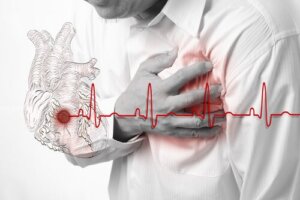How to Detect a False Heart Attack


Written and verified by the doctor Leonardo Biolatto
A myocardial infarction, or heart attack, is when the heart stops receiving sufficient blood supply and the tissue is damaged. It’s a fairly common situation in the emergency room. However, many of the people who come to the emergency room suffer false heart attacks that they mistake for a real one.
In fact, according to the Spanish Society of Cardiology, one in ten diagnosed heart attacks is actually a false heart attack. Moreover, only one in five people who go to the emergency room claiming to be suffering a heart attack actually has one.
The problem with false heart attacks is that, if the diagnosis is incorrect, it can lead to the person undergoing invasive tests that aren’t free of risks. For this reason, we’ll explain below how to detect false heart attacks.
What are false heart attacks?
Thanks to series, movies, or even books, almost everyone knows the symptoms of a myocardial infarction. It involves a feeling of tightness and pain in the chest, as well as altered sensation in the left arm.
However, these symptoms can have many other causes. It’s common for the fear of suffering a heart attack to make the person believe that they’re suffering from one when they experience any of these signs. Hence, there are many false heart attacks.
However, this is an emergency, so there are a series of protocols that allow for the taking of rapid action. For example, the Heart Attack Code is a tool that allows doctors to tend to people suffering from a heart attack.
To activate this protocol, the person must meet certain criteria, both in terms of symptoms and test results. Doctors must perform an electrocardiogram to check the heart’s activity.
Even so, this type of tool also has false positives and can mask false heart attacks. The problem with this, as we mentioned earlier, is that these people are given invasive tests, such as catheterization, to try to treat them.

You may be interested in: 5 Habits to Help Prevent a Heart Attack
What are the real causes of false heart attacks?
False heart attacks may actually be another illness presenting similar symptoms. First of all, it may be a lesion of the muscles between the ribs. This often occurs when coughing very hard, for example.
In this case, the pain is stabbing and located on one of the sides in a quite specific way. In addition, it increases every time the chest moves with breathing or when coughing again.
Another situation that’s frequently confused with a heart attack is acid reflux. This is when the acidic contents of the stomach pass into the esophagus and cause the esophagus to contract. Sometimes, it manifests itself as a tight feeling in the chest, which can resemble a heart attack.
Pericarditis is an illness that also causes similar symptoms. It consists of an inflammation of the pericardium, which is one of the membranes that surround the heart. It produces continuous pain in the chest, in the area where the heart is located.
The difference between pericarditis and infarction is that the pain is milder in this case. In addition, it’s usually preceded by an infection, so this may give a clue. For example, it may occur after a cold.

You might like: Irregular Sleep Can Increase the Risk of Cardiovascular Problems
Emergencies
What we must keep in mind is that false heart attacks should be tended to and treated as an emergency until it’s proven that they’re not a real heart attack. Therefore, although it may be another illness, it’s essential that you see a doctor urgently.
Doctors should carry out a thorough examination of the person and decide whether any treatment is necessary. If this isn’t done, it could be a real heart attack and the person’s life could be at stake.
All cited sources were thoroughly reviewed by our team to ensure their quality, reliability, currency, and validity. The bibliography of this article was considered reliable and of academic or scientific accuracy.
- La activación del Código Infarto tiene una tasa de falsos positivos del 14% – El médico interactivo : El médico interactivo. (n.d.). Retrieved April 23, 2020, from https://elmedicointeractivo.com/la-activacion-del-codigo-infarto-tiene-una-tasa-de-falsos-positivos-del-14/
- Press, E. (n.d.). El 10% de los infartos diagnosticados es un falso positivo, especialmente en mujeres.
Uno de cada diez infartos diagnosticados es un falso positivo – Sociedad Española de Cardiología. (n.d.). Retrieved April 23, 2020, from https://secardiologia.es/comunicacion/notas-de-prensa/notas-de-prensa-sec/9405-uno-de-cada-diez-infartos-diagnosticados-es-un-falso-positivo
This text is provided for informational purposes only and does not replace consultation with a professional. If in doubt, consult your specialist.








